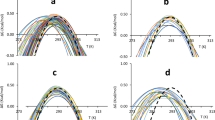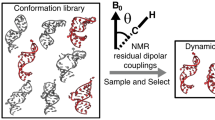Abstract
According to the ‘thermodynamic hypothesis’, the sequence of a biological macromolecule defines its folded, active (or ‘native’) structure as a global energy minimum in the folding landscape1,2. However, the enormous complexity of folding landscapes of large macromolecules raises the question of whether there is in fact a unique global minimum corresponding to a unique native conformation or whether there are deep local minima corresponding to alternative active conformations3. The folding of many proteins is well described by two-state models, leading to highly simplified representations of protein folding landscapes with a single native conformation4,5. Nevertheless, accumulating experimental evidence suggests a more complex topology of folding landscapes with multiple active conformations that can take seconds or longer to interconvert6,7,8. Here we demonstrate, using single-molecule experiments, that an RNA enzyme folds into multiple distinct native states that interconvert on a timescale much longer than that of catalysis. These data demonstrate that severe ruggedness of RNA folding landscapes extends into conformational space occupied by native conformations.
This is a preview of subscription content, access via your institution
Access options
Subscribe to this journal
Receive 51 print issues and online access
$199.00 per year
only $3.90 per issue
Buy this article
- Purchase on Springer Link
- Instant access to full article PDF
Prices may be subject to local taxes which are calculated during checkout




Similar content being viewed by others
References
Anfinsen, C. B. Principles that govern the folding of protein chains. Science 181, 223–230 (1973)
Bryngelson, J. D., Onuchic, J. N., Socci, N. D. & Wolynes, P. G. Funnels, pathways and the energy landscape of protein folding: a synthesis. Proteins Struct. Funct. Genet. 21, 167–195 (1995)
James, L. C. & Tawfik, D. S. Conformational diversity and protein evolution - a 60-year-old hypothesis revisited. Trends Biochem. Sci. 28, 361–368 (2003)
Zwanzig, R. Two-state models of protein folding kinetics. Proc. Natl Acad. Sci. USA 94, 148–150 (1997)
Dill, K. A. & Chan, H. S. From Levinthal to pathways to funnels. Nature Struct. Biol. 4, 10–19 (1997)
Schmid, F. X. & Blaschek, H. A. Native-like intermediate on the ribonuclease A folding pathway. Eur. J. Biochem. 114, 111–117 (1981)
Jennings, P. A., Finn, B. E., Jones, B. E. & Matthews, C. R. A reexamination of the folding mechanism of dihydrofolate reductase from Escherichia coli: verification and refinement of a four-channel model. Biochemistry 32, 3783–3789 (1993)
Kamagata, K., Sawano, Y., Tanokura, M. & Kuwajima, K. Multiple parallel-pathway folding of proline-free staphylococcal nuclease. J. Mol. Biol. 332, 1143–1153 (2003)
Dinner, A. R., Sali, A., Smith, L. J., Dobson, C. M. & Karplus, M. Understanding protein folding via free-energy surfaces from theory and experiment. Trends Biochem. Sci. 25, 331–339 (2000)
Frieden, C. Slow transitions and hysteretic behavior in enzymes. Annu. Rev. Biochem. 48, 471–489 (1979)
Flomenbom, O. et al. Stretched exponential decay and correlations in the catalytic activity of fluctuating single lipase molecules. Proc. Natl Acad. Sci. USA 102, 2368–2372 (2005)
Lu, H. P., Xun, L. & Xie, X. S. Single-molecule enzymatic dynamics. Science 282, 1877–1882 (1998)
English, B. P. et al. Ever-fluctuating single enzyme molecules: Michaelis-Menten equation revisited. Nature Chem. Biol. 2, 87–94 (2005); erratum 2, 168 (2006)
Herschlag, D. RNA chaperones and the RNA folding problem. J. Biol. Chem. 270, 20871–20874 (1995)
Treiber, D. K. & Williamson, J. R. Exposing the kinetic traps in RNA folding. Curr. Opin. Struct. Biol. 9, 339–345 (1999)
Chen, S.-J. & Dill, K. A. RNA folding energy landscapes. Proc. Natl Acad. Sci. USA 97, 646–651 (2000)
Pan, J., Thirumalai, D. & Woodson, S. A. Folding of RNA involves parallel pathways. J. Mol. Biol. 273, 7–13 (1997)
Zhuang, X. et al. Correlating structural dynamics and function in single ribozyme molecules. Science 296, 1473–1476 (2002)
Tan, E. et al. A four-way junction accelerates hairpin ribozyme folding via a discrete intermediate. Proc. Natl Acad. Sci. USA 100, 9308–9313 (2003)
Herschlag, D. Evidence for processivity and two-step binding of the RNA substrate from studies of J1/2 mutants of the Tetrahymena ribozyme. Biochemistry 31, 1386–1399 (1992)
Bevilacqua, P. C., Kierzek, R., Johnson, K. A. & Turner, D. H. Dynamics of ribozyme binding of substrate revealed by fluorescence-detected stopped-flow methods. Science 258, 1355–1358 (1992)
Ditzler, M. A., Rueda, D., Mo, J., Hakansson, K. & Walter, N. G. A rugged free energy landscape separates multiple functional RNA folds throughout denaturation. Nucleic Acids Res. 36, 7088–7099 (2008)
Lindahl, T., Adams, A. & Fresco, J. R. Renaturation of transfer ribonucleic acids through site binding of magnesium. Proc. Natl Acad. Sci. USA 55, 941–948 (1966)
Korennykh, A. V., Plantinga, M. J., Correll, C. C. & Piccirilli, J. A. Linkage between substrate recognition and catalysis during cleavage of sarcin/ricin loop RNA by restrictocin. Biochemistry 46, 12744–12756 (2007)
Levinthal, C. Are there pathways for protein folding? J. Chim. Phys. 65, 44–45 (1968)
Russell, R. et al. Exploring the folding landscape of a structured RNA. Proc. Natl Acad. Sci. USA 99, 155–160 (2002)
Zhuang, X. et al. A single-molecule study of RNA catalysis and folding. Science 288, 2048–2051 (2000)
Sattin, B. D., Zhao, W., Travers, K., Chu, S. & Herschlag, D. Direct measurement of tertiary contact cooperativity in RNA folding. J. Am. Chem. Soc. 130, 6085–6087 (2008)
Russell, R. & Herschlag, D. Probing the folding landscape of the Tetrahymena ribozyme: commitment to form the native conformation is late in the folding pathway. J. Mol. Biol. 308, 839–851 (2001)
Narlikar, G. J., Bartley, L. E., Khosla, M. & Herschlag, D. Characterization of a local folding event of the Tetrahymena group I ribozyme: effects of oligonucleotide substrate length, pH, and temperature on the two substrate binding steps. Biochemistry 38, 14192–14204 (1999)
Acknowledgements
We thank T. H. Lee, B. Cui, H. Kim, W. Zhao and other current and former members of the Chu laboratory, and the Mabuchi laboratory, for technical assistance. We thank members of the Herschlag laboratory for discussions and comments on the manuscript. Financial support for this work was provided by US National Institutes of Health (NIH) programme project grant P01-GM-66275 and NIH grant GM49243, to D.H. We thank the Stanford Bio-X Program for fellowship support to S.V.S.
Author Contributions All authors contributed to the experimental design and writing of the manuscript. S.V.S. performed the experiments and M.G. and S.V.S. carried out data analysis.
Author information
Authors and Affiliations
Corresponding author
Ethics declarations
Competing interests
The authors declare no competing financial interests.
Supplementary information
Supplementary Information
This file contains Supplementary Figures S1- S7 with Legends, Supplementary Data, Supplementary Table 1 and Supplementary References. (PDF 559 kb)
Rights and permissions
About this article
Cite this article
Solomatin, S., Greenfeld, M., Chu, S. et al. Multiple native states reveal persistent ruggedness of an RNA folding landscape. Nature 463, 681–684 (2010). https://doi.org/10.1038/nature08717
Received:
Accepted:
Issue Date:
DOI: https://doi.org/10.1038/nature08717
This article is cited by
-
Metal ions and sugar puckering balance single-molecule kinetic heterogeneity in RNA and DNA tertiary contacts
Nature Communications (2020)
-
Base-pair ambiguity and the kinetics of RNA folding
BMC Bioinformatics (2019)
-
Disordered RNA chaperones can enhance nucleic acid folding via local charge screening
Nature Communications (2019)
-
Local-to-global signal transduction at the core of a Mn2+ sensing riboswitch
Nature Communications (2019)
-
A proline switch explains kinetic heterogeneity in a coupled folding and binding reaction
Nature Communications (2018)
Comments
By submitting a comment you agree to abide by our Terms and Community Guidelines. If you find something abusive or that does not comply with our terms or guidelines please flag it as inappropriate.



